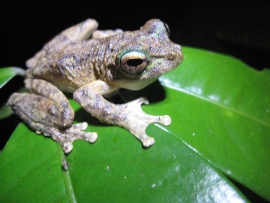|
|
Wetland fauna (animals)Wetland ecosystems contain species that have evolved in a wet environment. Adaptations to an aquatic life are often obvious: fins on fish, webbed feet on frogs and ducks, and waterproof feathers or fur on darters and platypus. Other adaptations are harder to see, e.g. gills on mayfly larvae and tadpoles tails that disappear as the tadpoles change into frogs; salt glands on the tongues of crocodiles that remove excess salt in brackish conditions.
As many of the wetlands in Queensland lack permanent inundation and can be dry for long periods, wetland fauna need traits to enable them to survive these dry times. Many are capable of rapid and long-distance dispersal so that they can recolonise recently re-wet habitats. For example, some species of aquatic insects can appear in rain puddles soon after they form. Some fish, like the spangled perch, swim wherever they can get to after heavy rain, giving the impression it has ‘rained fish’ but allowing them to colonise newly wet pools. Freshwater mussels can seal their shells with mucus and can live for years without water, only opening again when re-wet. Many others have dormant eggs which form egg-banks (similar to plant seed banks) in wetland sediments, hatching when the wetland is re-wet. Some insects can remain dormant as juveniles under rocks or buried in drying sediments. Many species can burrow deep into stream sediments to access shallow groundwater and live there until wetter times return. These adaptations to resist drying, or to be resilient and rapidly recolonise after re-wetting, allow Queensland’s wetland fauna to persist through the wet and dry cycles characteristic of our variable climate[1].
The degree that fauna are dependent on wetlands ranges from those with complete dependence (yabbies and freshwater fish), to those that exist in other habitats but need wetlands for part of their life cycle, e.g. grey and ornamental snakes hunt in wetlands where they feed on frogs. Some animal species are so reliant on wetlands that evidence of their occurrence can confirm the presence of a wetland, e.g. crustacean exoskeletons or crayfish burrows. A list of these fauna wetland indicator species is provided to assist in determining whether an area is a wetland. Flora and fauna data is spatially referenced (using latitudes and longitudes) so it can be viewed and queried spatially using WetlandMaps or WetlandSummary or Wildlife Online. Additional information
Pages under this sectionReferences
Last updated: 13 October 2023 This page should be cited as: Department of Environment, Science and Innovation, Queensland (2023) Wetland fauna (animals), WetlandInfo website, accessed 8 May 2025. Available at: https://wetlandinfo.des.qld.gov.au/wetlands/ecology/components/biota/fauna/ |

 — Department of the Environment, Tourism, Science and Innovation
— Department of the Environment, Tourism, Science and Innovation



